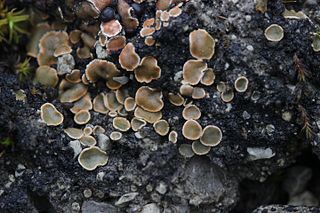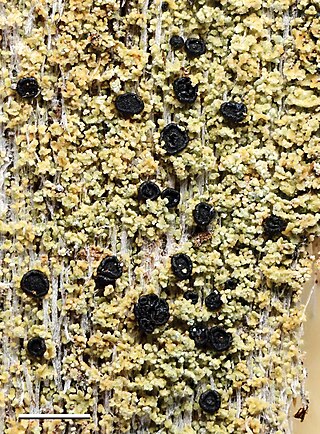
The Cladoniaceae are a family of lichen-forming fungi in the order Lecanorales, comprising about 560 species distributed amongst 18 genera. This family is one of the largest among lichen-forming fungi and is globally distributed, from Arctic tundra to tropical rainforests, favouring humid environments while being intolerant of arid conditions. Molecular phylogenetics has significantly advanced the understanding of their complex taxonomic history, revealing intricate evolutionary relationships and leading to a refined classification. Notable members include reindeer moss and cup lichens of the genus Cladonia, which consist of about 500 species and forms a significant part of the diet for large mammals in taiga and tundra ecosystems.

Psora is a genus of lichen-forming fungi in the family Psoraceae. Members of the genus are commonly called fishscale lichens. Lichens in the genus Psora generally have a squamulose thallus and anthraquinones in the hymenium. Photobiont partners of Psora lichens include members of the green algal genera Asterochloris, Chloroidium, Myrmecia, and Trebouxia.

The Sphaerophoraceae are a family of lichen-forming fungi in the order Lecanorales. Species of this family have a widespread distribution, especially in southern temperate regions, with particular diversity in cool temperate rainforests and highly oceanic areas of both hemispheres.

Cladonia asahinae, the pixie cup lichen or Asahina's cup lichen, is a species of cup lichen in the family Cladoniaceae. C. asahinae occurs in Europe, North America, southern South America, and the Antarctic. It typically grows in high moisture environments in soil rich in humus or on dead wood.

The Lecideaceae are a family of lichen-forming fungi in the order Lecideales. It contains about 30 genera and roughly 250 species. A major distinguishing characteristic of the family is the lecanoroid form of the fruiting bodies: typically circular, dark, and without a thalline margin. Most species in the family are lichenised with green algae, although a few species, scattered amongst several genera, are lichenicolous—they live on other lichens. Lecideaceae lichens tend to grow on rocks, wood, and soil. Several Lecideaceae species accelerate the weathering of rock surfaces, a process known as pedogenesis, by extending their hyphae into cracks and expelling rock flakes. This contributes to significantly faster weathering rates in certain environments, impacts various materials from natural rocks to man-made Sekishu roof tiles, and involves key biomolecules identified for survival and biodeterioration, including compounds to withstand intense ultraviolet radiation.

Megalaria is a genus of lichen-forming fungi in the family Ramalinaceae. It contains 44 species of crustose lichens, the majority of which grow on bark.
Inoderma is a genus of lichen-forming fungi in the family Arthoniaceae. It was resurrected for use in 2015 for a small group of species with the following features: elevated, white pruinose pycnidia, immersed to adnate white pruinose apothecia, and a weakly gelatinized hymenium. Inoderma byssaceum was assigned as the type species for the genus.
Schaereria bullata is a species of lichen in the family Schaereriaceae. It is found in the alpine regions of Tasmania, Australia. This lichen species is characterized by its dark brown to grey-brown thallus, which forms irregular patches over soil or bryophytes, and consists of granules that coalesce to create convex to bullate squamules. The lichen also features distinctive apothecia, which are roundish and typically superficial, and spherical spores.
Menegazzia endocrocea is a species of foliose lichen in the family Parmeliaceae. It is found in Australia. The lichen forms irregular rosettes up to 10 cm wide with hollow, cylindrical lobes that branch dichotomously, featuring a pale grey to cream-grey upper surface with roundish holes and a wrinkled, black lower surface. It has scattered apothecia with a reddish-brown disc, two-spored asci, and abundant pycnidia, identified chemically by compounds like atranorin and stictic acid.

Xylopsora canopeorum is a squamulose (scaly), corticolous (bark-dwelling) lichen species in the family Umbilicariaceae. Discovered in the canopies of Sequoia sempervirens in California, United States, it was formally described as new to science in 2018. It is endemic to the central coastal region of California, living within the unique ecosystems of Big Basin Redwoods State Park and Armstrong Redwoods State Natural Reserve, areas known for their ancient coast redwood forests. The lichen evolves from a crust-like to scale-like form, developing into coral-like crusts as it matures, complemented by distinctive flat, black reproductive discs. This species has varying greyish-green to medium brown coloration and occasionally forms soralia, which release powdery reproductive propagules called soredia. Xylopsora canopeorum is distinguished from closely related species by its smaller, partly coral-like squamules (scales), the occurrence of soralia on its surface, and in some specimens, the presence of both thamnolic and friesiic acids within the thallus.
Knightiellastrum is a single-species fungal genus in the family Icmadophilaceae. This monotypic genus the contains the corticolous (bark-dwelling), squamulose lichen species Knightiellastrum eucalypti, found in Tasmania, Australia.
Xanthoparmelia elevata is a species of foliose lichen in the family Parmeliaceae, described by John Alan Elix in 2003. It is found exclusively in Western Australia, growing on granite outcrops in the region's southwest.

Romjularia is a fungal genus in the family Lecideaceae, containing the single species Romjularia lurida, a saxicolous and terricolous squamulose lichen.
Phormopsora is a fungal genus in the family Pannariaceae. It comprises a single species, Phormopsora isabellina. The genus was proposed in 2020 based on molecular and morphological studies of a lichen previously classified in the genera Psoroma and Pannaria. Phormopsora is characterised by its large, scale-like structures called squamules that form pale grey rosettes, and by the presence of unique lichen substances not found in other members of its family. The species is primarily found in southern South America, particularly in Chile, where it grows on the trunks of evergreen Nothofagus trees in humid, temperate rainforests. Its distinctive features include well-developed structures containing nitrogen-fixing cyanobacteria, and spores with a distinctive outer wall that has irregular swellings and thread-like extensions at the tips.
Pseudoheppia is a fungal genus in the family Lichinaceae. It contains a single species, Pseudoheppia schuleri, a saxicolous (rock-dwelling) squamulose lichen.
Boreoplaca is a fungal genus in the family Ophioparmaceae. It comprises the single species Boreoplaca ultrafrigida, a saxicolous (rock-dwelling), squamulose lichen. Both the genus and species were described in 1994 by the Norwegian lichenologist Einar Timdal. The lichen is found in Eastern Siberia, the Russian Far East as well as in adjacent territories of north-east China, and in South Korea. The main characteristics of the lichen are its squamulose thallus, black lecideine apothecia, and Fuscidea-type asci.
Joergensenia is a fungal genus in the family Pannariaceae. It comprises a single species, Joergensenia cephalodina, which is a corticolous (bark-dwelling), squamulose lichen found in southern South America.
Parallopsora is a small genus of lichen-forming fungi in the family Ramalinaceae. Established in 2018, the genus contains three species that were previously classified under a related genus, Phyllopsora. These lichens form small, scale-like growths that overlap like roof tiles and typically appear pale green to bluish-green in colour. They reproduce through both small brown fruiting bodies and sometimes through powdery structures on their surface. The species are known to grow in tropical rainforests, particularly in Brazil, Peru and Cuba.

Cladonia grayi, commonly known as Gray's cup lichen or Gray's pixie cup, is a species of fruticose lichen in the family Cladoniaceae. It is characterised by small, leaf-like squamules forming its primary thallus and distinctive upright podetia that develop into goblet-shaped cups. The species contains several unique lichen substances, primarily grayanic acid, which causes it to glow light blue under ultraviolet light, and has also been found to produce protective pyrrolopyrazine compounds. Its photobiont is the green algal species Asterochloris glomerata.

Cladonia floerkeana is a species of fruticose lichen in the family Cladoniaceae. The species produces distinctive bright red spore-bearing structures (apothecia) on thin, upright stalks (podetia) that can be variably branched. These stalks may be smooth, rough, or covered in tiny scales. The species was first described by Elias Magnus Fries in 1824 as Cenomyce floerkeana and later transferred to the genus Cladonia by Heinrich Gustav Flörke in 1828. C. floerkeana is closely related to Cladonia macilenta, from which it is distinguished by its lack of soredia and its chemical properties. Commonly known as gritty British soldiers or Bengal match lichen, this species functions as a pioneer organism in nutrient-poor environments.










